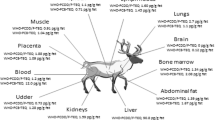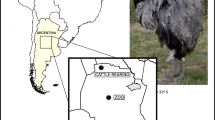Abstract
The exposure of red foxes to hexachlorobenzene (HCB), dichlorodiphenyltrichloroethan (DDT), DDT derivatives, and polychlorinated biphenyls (PCBs) in central Italy was determined by analyzing muscle and adipose tissue samples from 57 red foxes collected in 1992–1993 in three areas of Tuscany, each characterized by different levels of anthropization. Chemical analysis showed that HCB occurred in low concentrations, ranging from an average of 0.08 μg/g lipid basis in fat of foxes from Pisa, the least agricultural area, to 1.06 μg/g in muscle of those from Grosseto, the least industrialized area. DDTs were calculated as the sum of the op′ and pp′DDT isomer concentrations and the DDT derivatives DDE and DDD. The lowest values of DDTs were found in foxes from Pisa, with mean values in muscle of 0.55 μg/g and 0.14 μg/g in fat. In the outskirts of Siena, the corresponding values were 1.16 μg/g and 0.49 μg/g. Higher values were found in the Grosseto area: 4.17 μg/g in muscle and 0.67 μg/g in fat. The most abundant DDT was pp′DDE in all areas, constituting more than half of total DDTs. Mean and standard deviations of PCB concentrations (calculated as the sum of the 31 identified and quantified congeners), were 20.2 μg/g in muscle and 7.2 μg/g in fat of red foxes from the Siena area. Values in the Pisa area were lower (7.6 μg/g in muscle and 1.8 μg/g in fat), whereas the highest levels were found in the Grosseto area (38 μg/g in muscle and 7.5 μg/g in fat). PCB fingerprints showed that hexa- and heptachlorobiphenyls were the most common congeners, although amounts differed between the three localities and the two tissues considered. As far as PCB composition is concerned, detailed observation revealed that although the three areas highly differed between each other, the most abundant congeners were the 22′344′5′ (PCB 138) and 22′44′55′ (PCB 153) hexachlorbiphenyls and 22′33′44′5 (PCB 170) and 22′344′55′ (PCB 180) heptachlorobiphenyls; these accounted for over 60% of total PCB residues in muscle and fat. Concentrations of the remaining PCB congeners were all lower than 5% of total PCBs, with the exception of octachlorobiphenyl 22′33′44′55′ (PCB 194) in fat tissue.
Foxes may be suitable biological indicators to detect organochlorine contamination in the environment because of their catholic food habits. This information may be used to select specific bioindicators for assessing the relative level of pollutants in that area.
Similar content being viewed by others
Author information
Authors and Affiliations
Additional information
Received: 8 March 2000/Accepted: 9 July 2000
Rights and permissions
About this article
Cite this article
Corsolini, S., Burrini, L., Focardi, S. et al. How Can We Use the Red Fox as a Bioindicator of Organochlorines?. Arch. Environ. Contam. Toxicol. 39, 547–556 (2000). https://doi.org/10.1007/s002440010139
Published:
Issue Date:
DOI: https://doi.org/10.1007/s002440010139




